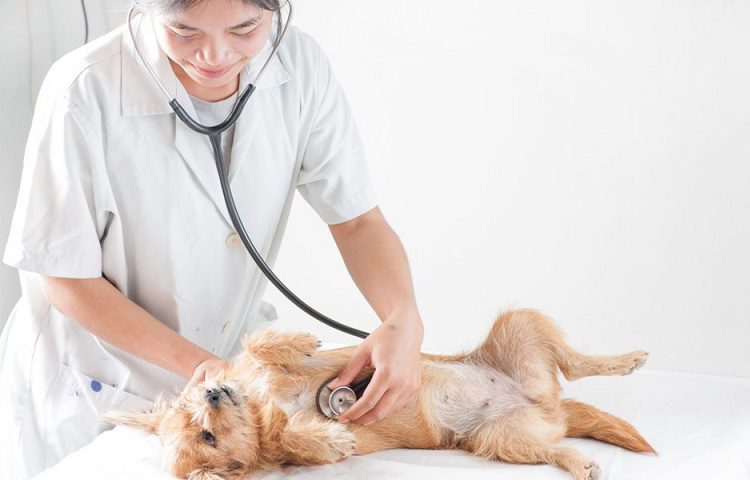Last Updated: 2 years ago
Some dog owners purposely breed their dogs. Others wake up one morning to the surprise that their dog is pregnant.
No matter why your dog is pregnant, it’s important to understand how their body works so you can provide the best care possible.
Providing great care for your pregnant dog starts with understanding how dog pregnancy works. In addition to knowing how long dogs are pregnant, this information helps you make the process much smoother and less stressful.
Now let’s look at a few of the most important factors related to dog pregnancy.
How Long Do Dogs Stay Pregnant?
According to Pets Web MD, the gestation period for most dog breed’s lasts between 58 and 65 days. It’s easy to confirm that your dog is pregnant by using an ultrasound or taking a blood test.
Though dogs can become pregnant at any point once they’re mature, it’s best to wait until your dog is at least two years old before breeding. For some breeds, like Boxers, you want to wait until they are at least three years old.
Simply put, you want your dog to be fully mature before they have puppies. Not only will this ensure the safety of the mother and puppies, but it will also make the process of raising the puppies easier.
Once mature, a female dog goes into heat approximately every 6 months. The cycle of heat lasts around 3 weeks at a time. Many female dogs skip heat cycles during their lives.
Signs Your Dog is in Heat
The key to telling if your dog is in heat is being observant. Take note of changes in their body and their behavior. This will help you figure out when their heat will begin.
Fortunately, the signs are straightforward. Banfield Pet Hospital states that the first sign is a swollen vulva and a bloody discharge.
The eggs have not yet been released at this point, and your dog likely won’t show any change in behavior. However, male dogs will likely be more drawn to her already.
After between 6 and 10 days, your dog becomes fertile. The bleeding will change from a primarily pink to a primarily sandy color. You will notice that your dog welcomes male attention more than she did in the first stage.
Signs Your Dog is Pregnant
A number of signs point to the early stages of dog pregnancy. These include nipple growth and behavioral changes, as well as a decreased appetite and decreased activity levels.
As the glands and tissues under your dog’s nipples swell to make room for milk, you’ll notice that the nipples appear large. Your dogs lack of appetite is similar to that of morning sickness in humans. Her need to sleep more during the day is also related to these bodily changes.
Behavioral changes in pregnant dogs vary widely. They depend not only on the breed of the dog but on the dog’s individual personality as well. Some dogs prefer to be left alone during pregnancy, while others become much more affectionate.
The Dog Gestation Period

Vet West Animal Hospitals says that puppies develop rapidly during gestation. Like human babies, a few milestones occur at specific points.
- Day 32: Embryos take shape. The face becomes prominent, and eyelids take form.
- Day 35: – Toes become visible.
- Day 45: Coat and skeleton begin to form.
- Day 50: Skeletons form to the point where the vet can take x-rays. This allows them to count the number of puppies.
- Day 58: Females look for area to nest. You should make a comfortable place for her.
Caring For A Pregnant Dog
A whole lot goes into the care of a pregnant dog. It starts with predicting when your dog will give birth. If you know the day they became pregnant, you can mark your calendar 56 days into the future. Once this day comes, you should not leave your dog alone if at all possible.
Continue to feed your dog like normal for the first few weeks. After a few weeks, you should mix their food with a small amount of puppy food. Most vets recommend that your dog only eat puppy food during the final week of pregnancy.
You should also switch from the standard two-meals-a day routine to several small meals throughout the day.
Most of the time, you don’t need to add any special supplements to the diet of a pregnant dog. However, it’s always smart to check with your vet to see what they personally recommend.
Ensure that your dog gets regular exercise during pregnancy. Avoid strenuous exercise, but make sure they’re still stretching their legs. You want them to maintain their muscle tone and prevent excessive weight gain.
As we mentioned above, prepare a comfortable place for your dog a week before the predicted birth of their puppies. This gives your dog a comfortable place to give birth and help their new litter.
Some vets recommend giving your dog a natural dietary supplement when they begin lactating. Basically, this supplement helps them produce more milk. As always, consult your vet before doing this.
Do You Need To Have A Vet Present?

Most dogs will be perfectly fine delivering their puppies alone. The vast majority of the time assistance isn’t required. It’s their natural instinct to give birth to and raise puppies.
With that said, you don’t need your vet to be on standby. Instead, talk to them beforehand to learn any tips that can help the birth go more smoothly.
However, there are a handful of warning signs that warrant calling your vet as soon as possible. These include:
- Green or black discharge does not follow birth.
- a puppy that cannot be removed from its mother.
- 4 hours or more between puppy deliveries.
- Dog in labor for 2 hours without puppies.
- Dog panting heavily, vomiting, or trembling.
- Pregnancy lasts longer than 65 days.
Conclusion
Your dog’s pregnancy is an exciting time. It means that puppies are on the way! Yet it can also be very stressful.
Use the tips and information above to make the pregnancy process as smooth as possible.
And rest assured that it’s your dog’s natural instinct to give birth. Though you can certainly help make the process more comfortable for them, they’ll likely be more than fine left to their own devices.
Resources:



